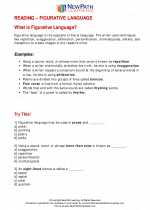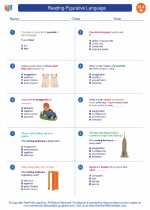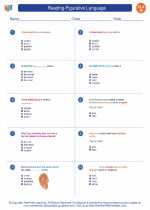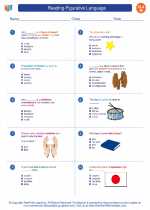Figurative Language Study Guide
Definition
Figurative language involves the use of words, phrases, and expressions in a non-literal way to create a particular effect. It adds depth and imagery to writing.
Types of Figurative Language
- Simile: A comparison using "like" or "as." Example: "She is as brave as a lion."
- Metaphor: A direct comparison without using "like" or "as." Example: "The world is a stage."
- Personification: Giving human characteristics to non-human things. Example: "The trees whispered in the wind."
- Hyperbole: Exaggerated statements or claims not meant to be taken literally. Example: "I've told you a million times."
- Onomatopoeia: Words that imitate the natural sounds of things. Example: "Buzzing bees."
- Alliteration: The repetition of initial consonant sounds. Example: "Sally sells seashells by the seashore."
- Idioms: Phrases that have a figurative meaning different from the literal meaning. Example: "It's raining cats and dogs."
- Symbolism: The use of symbols to represent ideas or qualities. Example: The color green symbolizing envy or growth.
Why Figurative Language is Used
Figurative language is used to evoke emotions, create vivid mental images, and add depth to writing. It can make the reader experience the text in a more profound way and help convey complex ideas more effectively.
Identifying and Analyzing Figurative Language
When analyzing a text for figurative language, it's important to look for words or phrases that don't have a literal meaning. Consider the effect the language has on the reader and how it contributes to the overall theme or message of the text.
Practice Exercises
1. Read a passage from a book or poem and identify at least three different types of figurative language used.
2. Write your own sentences using similes, metaphors, or other types of figurative language to describe everyday experiences or objects.
Conclusion
Figurative language adds color and depth to writing, allowing authors to create vivid imagery and convey complex ideas in an engaging way. By understanding and identifying figurative language, readers can gain a deeper appreciation for the texts they encounter.
[Reading-Figurative Language] Related Worksheets and Study Guides:
.◂English Language Arts Worksheets and Study Guides Eighth Grade. Reading-Figurative Language

 Worksheet/Answer key
Worksheet/Answer key
 Worksheet/Answer key
Worksheet/Answer key
 Worksheet/Answer key
Worksheet/Answer key
